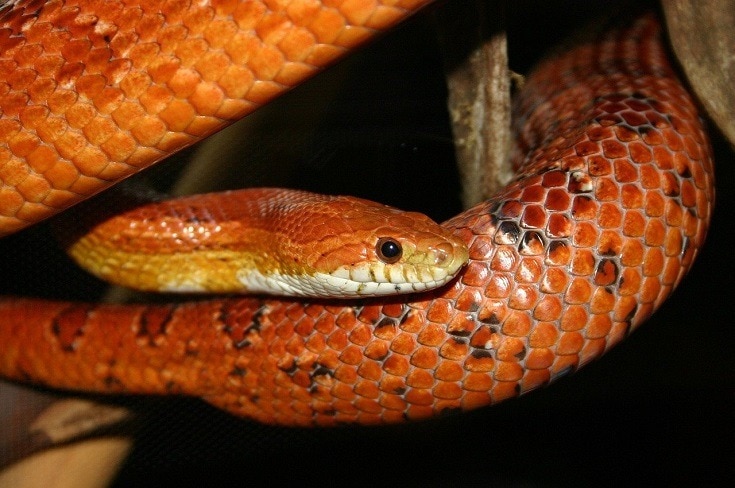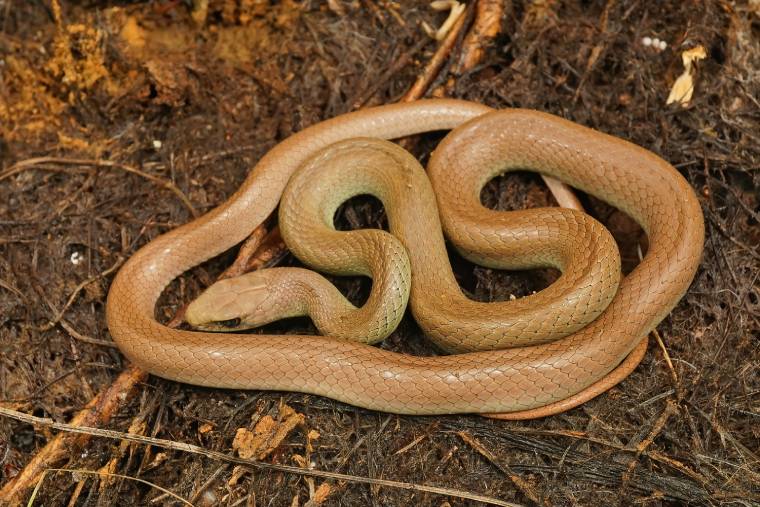
The corn snake is a beautiful, docile creature enjoyed by both children and adults alike. The name “corn snake” comes from their tendency to be found around cornfields in the U.S.
If you have ever been fortunate enough to spot one slithering through the grass, or resting on top of an old log, then you know just how fascinating these creatures can be!
This article will provide all the information you need to care for your new addition, including feeding types, habitats/temperature requirements, as well as fun facts about this fantastic animal!
Quick Facts about Fancy Corn Snakes
| Species Name: | P. Guttatus |
| Common Name: | Corn Snake |
| Care Level: | Beginner |
| Lifespan: | 20 – 30 years |
| Adult Size: | 3 – 5 feet |
| Diet: | Small rodents |
| Minimum Tank Size: | 20 gallons |
| Temperature & Humidity: | Temperature: 75°F – 85°F Humidity: 40 – 50% |
Do Fancy Corn Snakes Make Good Pets?

Corn snakes are an attractive choice for a pet that is both affordable and easy to care for. They have great temperaments, are non-venomous, making them excellent pets in the home or at school.
The corn snake is an easy-going animal that enjoys nothing more than being handled by humans. It’s not uncommon for people who have one in captivity to let them roam free around the house when they’re seeming well behaved.
While they rarely bite, their small teeth do not pose a risk to human health.
Finally, the corn snake is native to the U.S, and it’s always great to show a little pride in your country’s native animals!
Appearance
Fancy corn snakes are what is known in the snake world as a morph. A morph is a snake of the same species, but that has slightly different colors or shapes.
Some morphs result from breeding one species to another, while others are created by crossing an animal from each side of its family tree together to ensure that the best traits are passed down from both sides.
The fancy corn snake is a term to regroup any corn snake that doesn’t have the traditional black and red colors.
How to Take Care of Fancy Corn Snakes
This small snake is incredibly easy to care for, even for beginners. There are, however, a few things you should keep in mind when bringing a corn snake into your home.
Habitat, Tank Conditions & Setup

Tank
Due to their small size, corn snakes can be kept in a variety of different tanks ranging from 20 gallons to 30 gallons.
Be sure that the cage setup is large enough for your snake’s needs and that you can maintain it well, even if corn snakes don’t require high upkeep compared to other reptiles such as bearded dragons or iguanas.
The tank should be cleaned regularly by removing fecal matter and old, soiled substrate. Be sure to provide a hiding spot for your snake in the tank that is large enough for it to fit into comfortably.
Lighting
Corn snakes do not need any specific lighting requirements to survive. We recommend using a fluorescent light bulb or a desk lamp to provide ambient light for the tank. You’ll probably be spending many hours gazing at your snake, and it’s important to give a gentle light that will not harm the animal.
Heating (Temperature & Humidity)
Corn snakes are ectothermic, meaning they rely on external sources of heat in order to regulate their body temperature. They have very few scales that can serve as insulation against cold surfaces, so it is important to use an under-tank heating pad if your snake is housed in a cool environment.
A heat lamp should be used when the ambient temperature of your room is below 70°F degrees or when it falls under 60°F, and these temperatures can often be found in basements.
Corn snakes do not require any specific humidity levels to survive as long as they are provided with fresh water daily!
Substrate
Corn snakes can be kept on many different types of bedding, from newspaper or paper towels to aspen shavings or cypress mulch. To maximize your pet’s comfort, it’s best to use a substrate that the snake can burrow in.
No matter what type you choose for your pet’s home, don’t forget to change it regularly and keep things clean!
Tank Recommendations
| Tank Type: | 20-gallon glass vivarium |
| Lighting: | Gentle lighting |
| Heating: | Heating pad/tape on the bottom of the enclosure |
| Best Substrate: | Aspen shavings |
Feeding Your Fancy Corn Snake
Most corn snakes are not fussy eaters and will accept a wide variety of prey items.
The most commonly fed food items are the following:
If you need to feed your snake on a schedule, then you can do this by feeding it once every three weeks. The more often you feed your snake, the better, though! Owners can feed corn snakes every few days if they see they are not getting bigger, especially as hatchlings.
When feeding a corn snake, it is important to ensure that it has fresh water nearby and does not leave prey items in the cage for too long. You want to keep things clean so that your snake is healthy. Corn snakes are not great at hiding their prey items when eating, so they can be messy at times.
Diet Summary
| Rodents: | 95% of diet |
| Insects: | 4% of diet |
| Birds: | 1% of diet |
| Supplements Required: | N/A |
Keeping Your Fancy Corn Snake Healthy
You’ll know your fancy corn snake is healthy by looking at its colors and the shape of the snake. You don’t want it too skinny and always monitor any changes in behavior.
If your snake is shedding, it may want to be taken out of its enclosure for a bit to do so more efficiently. Also note that shedding can happen when you get new prey items or if something has been bothering them, like another animal being nearby.
You will also know something is up by how they’re acting. If your snake is really hiding, has not eaten in a few days, or looks ill, you should see a vet right away!
Common Health Issues
Some health issues your fancy corn snake may face include minor conditions like dehydration, bad shedding issues, along more serious problems like intestinal parasites.
Skin problems are the most common, ranging anywhere from cuts and grazes to abscesses and blisters
Lifespan
While this type of snake only lives 6-8 years in the wild, it can reach an incredible 23 years of age in captivity. Provided you took the correct steps to care for your pet snake, and you should have a reptilian friend for a long time!
Breeding
Corn snakes a pretty easy to breed, even for beginners.
Breeding season for corn snakes runs from March to May, with eggs being laid between May and June. The time frame is different for each snake, so you should keep an eye out for females that are amorous or gravid (ready to lay eggs).
The process will be hands-off for you, but make sure you provide a shallow container about 50% larger than the female so she can feel safe.
Are Fancy Corn Snakes Friendly? Our Handling Advice
Like most corn snakes, fancy corn snakes are extremely friendly. They can be handled by adults and children alike because of their small size and docile temperament.
To have the best experience possible when handling one, remember to have a firm grip but avoid squeezing too hard. There’s no need to be rough; just make sure the snake feels safe and happy.
Shedding & Brumation: What to Expect
Brumation for corn snakes is not necessary, and we recommend avoiding it unless you plan on breeding them. Corn snakes will shed their skin about six weeks after mating, and they may do so more than once in a row if conditions are right.
The process is simple: your corn snake will rub its nose on a rough surface, like a branch or rock. It will then shed its skin over the course of two to three hours while still hanging on to the object with its jaw and teeth.
The snake may go inside for this process, so make sure you allow it that opportunity if possible!
How Much Do Fancy Corn Snakes Cost?
The average price for adopting a corn snake is usually around $50-$100. Fancy corn snakes tend to be on the higher echelon of price ranges due to their uniqueness.
Before bringing your pet home, though, you need to buy a tank, an appropriately sized water dish, an under-tank heater, and a hide. These are the bare essentials to get your corn snake started in its new home!
Once it’s settled in, ongoing costs will include minimal food and the occasional vet visit.
Care Guide Summary
 Final Thoughts
Final Thoughts
If you’re looking for a small, docile pet that’s easy to care for and just as beautiful to look at, the fancy corn snake might be perfect for you!
They are so easy to manipulate that even children love them! With their bright coloration and inquisitive nature, these little guys will make any beginner feel confident in their abilities or serve as an excellent addition to an experienced snake owner’s collection.
Still undecided? Check out the rest of our blog to learn about hundreds of animals and find your new best friend.
Featured Image Credit: Alpha1Awareness, Pixabay



 Final Thoughts
Final Thoughts





